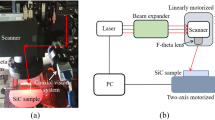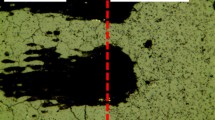Abstract
Silicon carbide (SiC) is heavily used in the industry due to its resistance to chemical wear and excellent mechanical properties such as high hardness and high stiffness. However, these properties make it difficult to produce micro and nanostructures on the surface of SiC by conventional methods. In this study, high-density microcones that protrude ~ 10 μm above the initial surface have been fabricated by nanosecond pulsed Nd:YAG laser irradiation (λ = 532 nm) on reaction-bonded SiC. Geometrically aligned cones were also fabricated by modifying the laser scanning path, and effect of different parameters such as pulse frequency, laser fluence was studied. It was observed that the surface morphology of microcones was affected by the pulse width and beam overlap. X-ray spectroscopy and Raman spectroscopy showed that the microcones were mainly composed of silicon. Formation of these cone structures made the surface highly superhydrophilic with a contact angle of ~ 0°.















Similar content being viewed by others
References
Suyama S, Itoh Y, Tsuno K, Ohno K (2005) Φ 650 mm optical space mirror substrate of high-strength reaction-sintered silicon carbide. Proc. SPIE:5868. https://doi.org/10.1117/12.616043
Toulemont Y, Breysse J, Piepot D, Miura S (2004) The 3.5 m all SiC telescope for SPICA. SPIE 5487:1001–1012. https://doi.org/10.1117/12.551405
Xing Y, Deng J, Wu Z, Wu F (2017) High friction and low wear properties of laser-textured ceramic surface under dry friction. Opt Laser Technol 93:24–32. https://doi.org/10.1016/j.optlastec.2017.01.032
Murzin SP, Balyakin VB (2017) Microstructuring the surface of silicon carbide ceramic by laser action for reducing friction losses in rolling bearings. Opt Laser Technol 88:96–98. https://doi.org/10.1016/j.optlastec.2016.09.007
Geiger M, Roth S, Becker W (1998) Influence of laser-produced microstructures on the tribological behaviour of ceramics. Surf Coatings Technol 100–101:17–22. https://doi.org/10.1016/S0257-8972(97)00581-1
Kondrashov V, Rühe J (2014) Microcones and nanograss: toward mechanically robust superhydrophobic surfaces. Langmuir 30:4342–4350. https://doi.org/10.1021/la500395e
Li XM, Reinhoudt D, Crego-Calama M (2007) What do we need for a superhydrophobic surface? a review on the recent progress in the preparation of superhydrophobic surfaces. Chem. Soc. Rev. 36:1350–1368
Younkin R, Carey JE, Mazur E, Levinson JA, Friend CM (2003) Infrared absorption by conical silicon microstructures made in a variety of background gases using femtosecond-laser pulses. J Appl Phys 93:2626–2629. https://doi.org/10.1063/1.1545159
Crouch CH, Carey JE, Warrender JM, Aziz MJ, Mazur E (2004) Comparison of structure and properties of femtosecond and nanosecond laser-structured silicon. Appl Phys Lett 84:1850–1852. https://doi.org/10.1063/1.1667004
Bäuerle D (2000) Laser Processing and Chemistry. Springer, Berlin
Brown MS, Arnold CB (2010) Fundamentals of laser-material interaction and application to multiscale surface modification. In: Sugioka K, Meunier M, Piqué A (eds) Laser Precision Microfabrication. Springer Series in Materials Science, vol 135. Springer, Berlin, Heidelberg, pp 91–120
Ness JN, Page TF (1986) Microstructural evolution in reaction-bonded silicon carbide. J Mater Sci 21:1377–1397. https://doi.org/10.1007/BF00553278
Humphreys RG, Signals R, Establishment R et al (1981) ReceDed 22. Energy 39:163–167
Philipp HR, Taft EA (1960) Silicon carbide – a high temperature semiconductor. In: O'Connor JR, Smiltens J (eds) . Pergamon Press, Oxford, London, New York, Paris, p 366
Groth R, Kauer E (1961) Absorption freier Ladungsträger in CdS. Phys Status Solidi 1:650–655. https://doi.org/10.1002/pssb.19610010609
Watanabe N, Kimoto T, Suda J (2014) Temperature dependence of optical absorption coefficient of 4H- and 6H-SiC from room temperature to 300 °C. Jpn J Appl Phys 53:12–15. https://doi.org/10.7567/JJAP.53.108003
Choyke WJ, Patrick L (1960) Silicon carbide – a high temperature semiconductor. In: O'Connor JR, Smiltens J (eds) . Pergamon Press, Oxford, London, New York, Paris, p 306
Yu G, Levinshtein ME, Rumyantsev SL (2001) Properties of Advanced SemiconductorMaterials GaN, AlN, SiC, BN, SiC, SiGe . Eds. Levinshtein M.E., Rumyantsev S.L., Shur M.S., John Wiley & Sons, Inc., New York. pp 93-148.
Duc DH, Naoki I, Kazuyoshi F (2013) A study of near-infrared nanosecond laser ablation of silicon carbide. Int J Heat Mass Transf 65:713–718. https://doi.org/10.1016/j.ijheatmasstransfer.2013.06.050
Samant AN, Daniel C, Chand RH, Blue CA, Dahotre NB (2009) Computational approach to photonic drilling of silicon carbide. Int J Adv Manuf Technol 45:704–713. https://doi.org/10.1007/s00170-009-2004-0
Fedorenko L, Medvid’ A, Yusupov M, Yukhimchuck V, Krylyuk S, Evtukh A (2008) Nanostructures on SiC surface created by laser microablation. Appl Surf Sci 254:2031–2036. https://doi.org/10.1016/j.apsusc.2007.08.048
Cappelli E, Orlando S, Mattei G, Montozzi M, Pinzari F, Sciti D (1999) Surface modifications of carbide ceramics induced by pulsed laser treatments. Appl Phys A Mater Sci Process 69:515–519. https://doi.org/10.1007/s003399900329
Shigematsu I, Kanayama K, Tsuge A, Nakamura M (1998) Analysis of constituents generated with laser machining of Si3N4and SiC. J Mater Sci Lett 17:737–739. https://doi.org/10.1023/A:1006606810476
Bai Y, Li L, Xue D, Zhang X (2016) Rapid fabrication of a silicon modification layer on silicon carbide substrate. Appl Opt 55:5814. https://doi.org/10.1364/ao.55.005814
Dutto C, Fogarassy E, Mathiot D (2001) Numerical and experimental analysis of pulsed excimer laser processing of silicon carbide. Appl Surf Sci 184:362–366. https://doi.org/10.1016/S0169-4332(01)00518-9
Chen SC, Cahill DG, Grigoropoulos CP (2002) Melting and surface deformation in pulsed laser surface micromodification of Ni-P Disks. J Heat Transfer 122:107. https://doi.org/10.1115/1.521441
György E, Mihailescu IN, Serra P, P´erez del pino A, Morenza JL (2002) Crown-like structure development on titanium exposed to multipulse Nd:YAG laser irradiation. Appl Phys A Mater Sci Process. https://doi.org/10.1007/s003390201307, 74, 755, 759
Taylor LL, Qiao J, Qiao J (2016) Optimization of femtosecond laser processing of silicon via numerical modeling. Opt. Mater. Express 6:2745–2758. https://doi.org/10.1364/OME.6.002745
Bradby JE, Williams JS, Wong-Leung J, Swain MV, Munroe P (2002) Nanoindentation-induced deformation of Ge. Appl Phys Lett 80:2651–2653. https://doi.org/10.1063/1.1469660
Koch K, Barthlott W (2009) Superhydrophobic and superhydrophilic plant surfaces: an inspiration for biomimetic materials. Philos Trans R Soc A Math Phys Eng Sci 367:1487–1509. https://doi.org/10.1098/rsta.2009.0022
Author information
Authors and Affiliations
Corresponding author
Additional information
Publisher’s note
Springer Nature remains neutral with regard to jurisdictional claims in published maps and institutional affiliations.
Rights and permissions
About this article
Cite this article
Meshram, T., Yan, J. Generation of microcones on reaction-bonded silicon carbide by nanosecond pulsed laser irradiation. Int J Adv Manuf Technol 108, 1039–1048 (2020). https://doi.org/10.1007/s00170-019-04672-4
Received:
Accepted:
Published:
Issue Date:
DOI: https://doi.org/10.1007/s00170-019-04672-4




